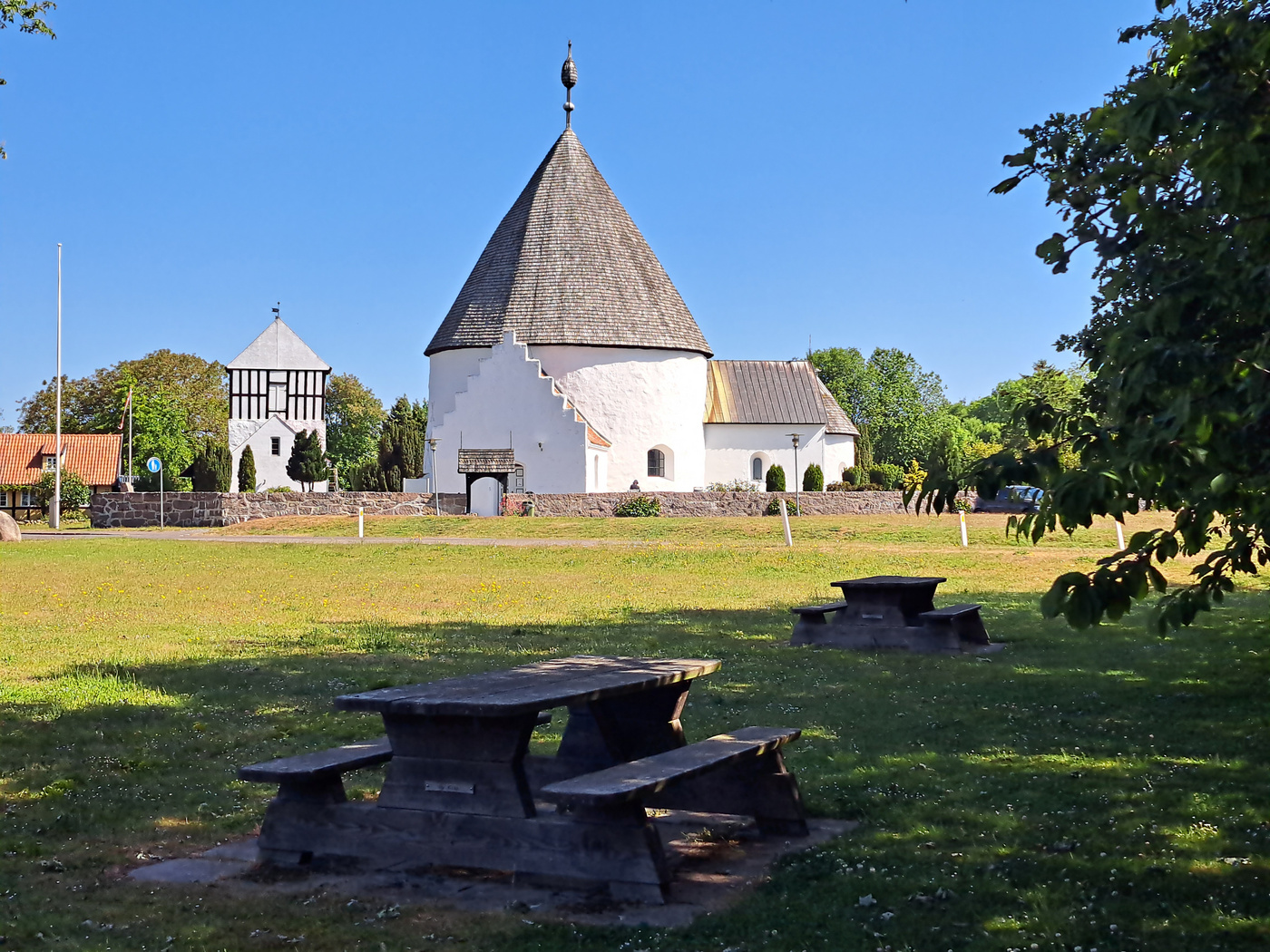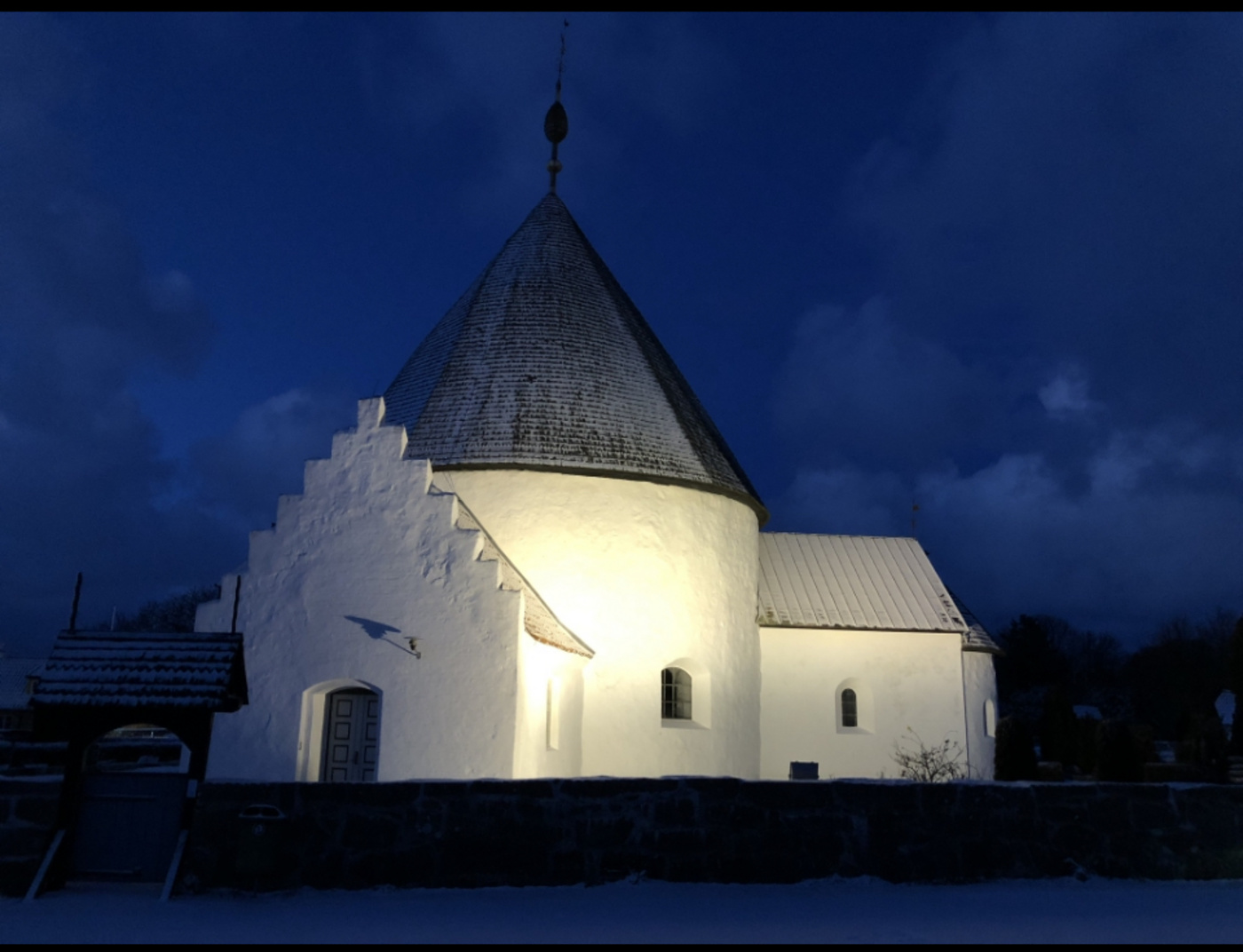Information about the chuch
In mediaeval times the church was called Ecclesia Omnium Sanctorum (All Saints Church). The present name dates back to the mid 1500s although that says nothing decisive about the age of the building.


The portals of the cemetery.
Access to the cemetery is through one of the three portals. They are old wooden gates of a local type with a roof and ornaments. The portal to the east is from 1809. The middle one is the oldest of its type in Bornholm. In the middle of the lintel the engraving says: AN 1678 NO MIS. The engraving on the portal to the west says: W L S ANNO 1776.
Outside the porch
To the left of the entrance is a Romanesque tombstone of granite with a big cross carved in relief.
In the porch
To the left hangs a table with copies of coins found in the floor of the church when it was restored 1958-60. The inscription states the type of coin and its approximate age.
The runic stone says (just about): Lo … had this stone erected for his son Sven – the right honourable esquire – and for his brother. May the holy Christ help the souls of the two brothers.
After the runic stone is a tombstone, which is rather worn-down as it was placed in the floor inside the church. From an inscription on the stone it appears that it was made in memory of vicar Jens Nilsøn, died March 1648 and his wife Hyldeborre Hansdaatter, whose year of death has never been inscribed. The upper part of the stone is a relief representing the Resurrection. The corners show oval reliefs of the four evangelists. At the edge all around the stone is a Latin inscription: Christ, Our Hope, has risen from the dead. Remember you must die. He who thirsts for Heaven must renounce the world. If God is with us, who can be against us?
The pastors’ tablets, contain the names of the vicars in the parish since the Reformation as well as information of period of service and year of death. Furthermore there are notes regarding the individual vicars, of which we mention but a few:
No. 6 Jacob Peder Tresløv, the last vicar at Hammershus, supported the rising in 1658.
No. 8 Hans Predbjørn, died in the pulpit on 24 March 1687
No. 12 Peder Truelsen Bernholdt. In 1743 he prayed for just public authorities in Bornholm
No. 13 Peder Sommer, presented the school and the poor with ample means
The plague tablet is on the opposite side, to the left of the window. On the tablet is inscribed the number of deaths in each parish in Bornholm during the two plague epidemics in 1618 and 1654.
The tablet to the right of the window was placed to commemorate the purchase of new pews in 1766.
Inside the church
The frescoes. A frieze above the pillar is divided into 13 panels with motifs from the Passion. The frieze starts in the panel just above the entrance door and goes on to the right:
- Judas kisses Jesus
- The servants of the high priest in the Garden of Gethsemane
- Christ is taken before Pilate
- Pilate on his throne (a little devil is whispering in his ear)
- The inscription is effaced, maybe the crowning with thorns
- The flogging
- Christ carries his cross
- The Crucifixion
- The entombment
- The Resurrection
- Noli me tangere
- The Ascension
- Uncertain
Above the portal to the north can be seen a medallion: the Lamb of God with chalice and banner of the cross and to the right of this and in two panels, the Annunciation. At the organ a painting of Christ and St. Thomas the Doubter.
These frescoes are made in the same style, i.e. the early Gothic from c. 1250 to 1300.
Between the north portal and rood arch is a so-called inauguration cross.
Above the rood arch is an ornamental edging crowned by a figure of Christ on the winged globe. He wears a loincloth and cloak and a reed mace in his tied hands. He has a halo around his head.
In the rood arch are stylized traceries of plants with leaves and flowers.
The pulpit was made during the newest restoration apart from the carvings, which were made in the workshop of the important carver Hinrich Ringering in Flensburg at the beginning of the 1600s. The four panels represent scenes from the Bible viz. The Annunciation in Nazareth, the Birth in Bethlehem, the Adoration of the Magi and the Circumcision.
The hourglass beside the pulpit has a painted inscription saying, Oh Man, do penance always. The glass runs sedulously, remember you must die then you thread carefully. This glass was given to the church by Albert Hartwig and his beloved wife Kirstine Hans Kofoeds Daatter for ornament and in remembrance of YOU Anno 1690.
In the choir
The font is made of grey limestone, in late Romanesque style and imported from Gotland.
The chandelier is from 1594 but was extensively restored in 1688. On top is a stylized and split double eagle, below a hanging ball with the year 1594 and two coats of arms, one of the renowned Kofoed family.
The stone slab which forms the Communion table is of limestone from Øland. The seven-branched candlestick was designed by the architect Havning.
The three stained-glass windows in the apse show Genesis (Father), Son and Holy Ghost. They were designed by Knud Henning Hansen, rural dean in Østerlars, and executed by H.J.Sorth, glazier in Rø in 1997.
In the bell tower
The church bells. The smallest is from 1639 and was founded for Sallerup Church in Scania (now Sweden). The biggest is younger, from 1725 and founded in Lübeck. The year 1640 is carved in the uppermost beam in the bell frame, which was meant for three bells.
The history of the building
The age of the church. The church was erected in the same period as the other medieaval churches in Bornholm, i.e. 1100-1200. Compared with the other three round churches on Bornholm Ny Kirke is normally regarded as the youngest.
The flagstone at the women’s entrance.
The building was erected without a real foundation wall. It is remarkable that a large, flat stone has been placed as a flagstone below the north portal (the women’s entrance). It measures 2.25 by 1.75 by 0.60 m. On the surface of the stone 12 cup-shaped marks can be seen. Archeologists think that according to popular belief that type of rock engraving stimulated fertility.
The material used for the building is mainly granite boulders, apart from the center column which is of the local Limensgade stone. This material is also used for most details, e.g. doors and windows.
The church portals. The porch is younger that the church itself, but still from mediaeval times. In the porch we see the south portal, rather well preserved in its original form. The semicircular lintel (tympanon) is made of one large sheet of limestone. The north portal is detached and the restoration 1959-60 tried to get it back to the original form.
The retaining walls to the west a rather low one and to the northeast a somewhat taller one were there already before 1733 and have been made to support the wall, as it was liable to break at a certain time.
The conical roof. From the upper part of the present church it is difficult to get a clear idea how visible the defensive measures were, but the present conical roof is definitely not the original one, but has replaced a flat roof or a low plank roof.
The rood arch was originally narrower, just about 2.50 m. Now remnants of side altar niches can be seen on each side of the arch. The windows have also been smaller. They have been 1 m square.

